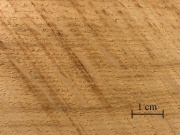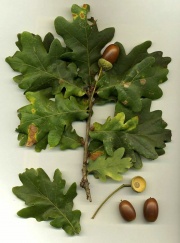English oak
Description
A relatively small oak, Quercus robur, grown abundantly in parks and on roadsides in England. English oak has a coarse, but straight grain that is usually a rich brown color. Flat sawn timber has a distinctive figuring while radial cut lumber has silver grain lines. The wood has a high Gallic acid content that will corrode Iron and other contacting metals. English oak is widely used in furniture, paneling, railway sleepers, cabinet, musical instruments, and ship building. The bark is used for tanning and dyeing.
Synonyms and Related Terms
Quercus robur; also called Quercus pedunculata (pedunculate oak); Almindelig Eg (Dan.); Stilk-Eg (Dan.); Stieleiche (Deut.); Deutsche Eiche (Deut.); Chêne pédonculé (Fr.); zomereik (Ned.); Stjälkek (Sven.); roble carvallo (Esp.); carvalho roble (Port.); farnia (It.); brown English oak; pollard oak
Collection Risks
Emits acetic acid with age. May corrode metals.
Physical and Chemical Properties
Large tree growing 25-40 m Bark=grayish brown, ageing with deep fissures Leave = oblong with 3 to 7 pairs of rounded lobes Fruit=narrow acorn with scaly cap, maturing in one season. Density = 40-50 ppcf
Additional Images
Resources and Citations
- Schoch, W., Heller, I., Schweingruber, F.H., Kienast, F., 2004:Wood anatomy of central European Species: Pedunculate Oak,Quercus robur L.
- F. H. Titmuss, Commercial Timbers of the World, The Technical Press Ltd., London, 1965
- Virginia Tech Dendrology website at www.fw.vt.edu/dendro/dendrology/main.htm (accessed Oct. 8, 2005)
- Wikipedia: http://en.wikipedia.org/wiki/English_oak (Accessed Oct. 8, 2005)
- Van Nostrand's Scientific Encyclopedia, Douglas M. Considine (ed.), Van Nostrand Reinhold, New York, 1976




